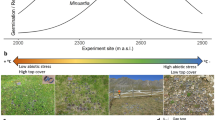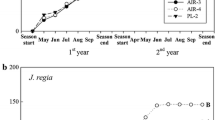Abstract
A field study was conducted to determine the effects of neighbour root exclusion and gap size on the seedling emergence and early growth of Bromus inermis. Seeds of B. inermis were added to artificially created gaps in an improved shortgrass steppe in northern China. Neighbour root exclusion was accomplished using PVC tubes sunk in the soil of gaps. Emergence and survival of seedlings were greater in all gaps than in the control (0-cm diameter), but better growth performance (height of seedling, leaves, tillers and dry weight per seedling) was observed only in large gaps (20- and 40-cm diameter) with neighbour root present and gaps without neighbour root presence. Seedling growth performance was improved by reducing root and shoot competition. Neighbour root exclusion provided a favourable environment for seedling establishment. Differences between gaps in light levels and topsoil temperature can explain the patterns of germination. These results confirm that B. inermis is a gap-enhanced species. Our study strongly suggests that asymmetric competition by adult neighbour plants negatively influences the establishment of B. inermis.






Similar content being viewed by others
References
Aguilera MO, Lauenroth WK (1993) Seedling establishment in adult neighbourhoods-intraspecific constraints in the regeneration of the bunchgrass Bouteloua gracilis. J Ecol 81:253–261
Aguilera MO, Lauenroth WK (1995) Influence of gap disturbances and type of microsites on seedling establishment in Bouteloua gracilis. J Ecol 83:87–97
Battaglia M, Reid JB (1993) The effect of microsite variation on seed germination and seedling survival of Eucalyptus delegatensis. Aust J Bot 42:169–181
Bradshaw L, Goldberg DE (1989) Resource levels in undisturbed vegetation and mole mounds in old fields. Am Midl Nat 121:176–183
Bullock JM, Clear Hill B, Silvertown J, Sutton M (1994) Gap colonization as a source of grassland community change: effects of gap size and grazing on the rate and mode of colonization by different species. Oikos 72:273–282
Bullock JM (2000) Gaps and seedling colonization. In: Fenner M (ed) Seeds. The ecology of regeneration in plant communities, CABI Publishing, Wallingford, pp 375–395
Burke MJ, Grime JP (1996) An experimental study of plant community invasibility. Ecology 77:776–790
Cahill JF, Casper BB (2002) Canopy gaps are sites of reduced belowground plant competition in a productive old field. Plant Ecol 164:29–36
Collins BS, Dunne KP, Pickett STA (1985) Response of forest herbs to canopy gaps. In: Picket STA, White PS (eds) The ecology of natural disturbance and patch dynamics. Academic, London, pp 218–234
Cook SJ, Ratcliff D (1984) A study of the effects of root and shoot competition on the growth of green panic (Panicum maxintum var. trichoglume). J Appl Ecol 21:971–982
Davies A, Dunnet t NP, Kendle AD (2000) The importance of transplant size and gap width in the botanical enrichment of pecies-poor grasslands in Britain. Restor Ecol 7:271–280
Denslow JS (1980) Gap partitioning among tropical rainforest trees. Biotropica Suppl 12:47–55
Fenner M (1985) Seed ecology. Chapman and Hall, London, pp 87–131
Goldberg DE, Werner PA (1983) The effects of size of opening in vegetation and litter cover on seedling establishment of goldenrods (Soldago spp.). Oecologia 60:149–155
Goldberg DE (1987) Seedling colonization of experimental gaps in two old-field communities. Bull Torr Bot Club 114:139–148
Grubb PJ (1977) The maintenance of species richness in plant communities: the importance of the regeneration niche. Biol Rev 52:107–145
Hanley ME, Fenner M, Edwards PJ (1996) Mollusc grazing and seedling survivorship of four common grassland plant species: the role of gap size, species and season recruitment in artificially created grassland gaps. Acta Oecol 17:331–341
Hanley ME (2004) Seedling herbivory and the influence of plant species richness in seedling neighbourhoods. Plant Ecol 170:35–41
Haugland E, Tawfiq M (2001) Root and shoot competition between established grass species and newly sown seedlings during spring growth. Grass Forage Sci 56:193–199
Hector GS, Escarre J, Sans FX (2004) Factors that limit the emergence and establishment of the related aliens Senecio inaequidens and Senecio pterophorus and the native Senecio malacitanus in Mediterrannean climate. Can J Bot 82:1346–1355
Hitchmough J D, Curtain H, Hammersley L, Kellow J (1996) Effect of gap width and turf type on the establishment of the ustralian forb Bulbine bulbosa. Restor Ecol 4:25–32
Hitchmough JD (2003) Effects of sward height, gap size, and slug grazing on emergence and establishment of Trollius europaeus (Globeflower). Restor Ecol 11(1):20–28
Hofmann M, Isselstein J (2004) Seedling recruitment on agriculturally improved mesic grassland: the influence of disturbance and management schemes. Appl Veg Sci 7:193–200
Hutchings MJ, Booth KD (1996) Studies of the feasibility of re-creating chalk grassland vegetation on ex-arable and. II. Germination and early survivorship of seedlings under different management regimes. J Appl Ecol 33:1182–1190
Isselstein J, Tallowin JRB, Smith REN (2002) Factors affecting seed germination and seedling establishment of fen-meadow species. Restor Ecol 10:173–184
Jutila HM, Grace JB (2002) Effects of disturbance on germination and seedling establishment in a coastal prairie grassland: a test of the competitive release hypothesis. J Ecol 90:291–302
Kotanen P M (1997) Effects of gap area and shape on recolonisation by grassland plants with differing reproductive strategies. Can J Bot 75:352–361
Kitajima K, Fenner M (2000) Ecology of seedling regeneration. In: Fenner M (eds) Seeds-the ecology of regeneration in plant communities, 2nd edn. CABI Publishing, pp 331–360
Louda SM, Potvin MA, Collinge SK (1990) Pre-dispersal seed predation, post dispersal seed predation and competition in the recruitment of seedlings of a native thistle in sandhills prairie (Nebraska, USA). Am Midl Nat 124:105–113
McConnaughay KDM, Bazzaz FA (1987) The relationship between gap size and performance of several colonizing annuals. Ecology 68(2):411–416
McConnaughay KDM, Bazzaz FA (1991) Is physical space a soil resource? Ecology 72:94–103
Morgan JW (1997) The effect of grassland gap size on establishment, growth and flowering of the endangered Rutidosis leptorrhynchoides (Asteraceae). J Appl Ecol 34:566–576
Moretto AS, Distel RA (1998) Recruitment of vegetation gaps for seedling establishment of two unpalatable grasses in a native grassland of central Argentina. Aust J Ecol 23:419–423
Oconnor TG (1996) Hierarchical control over seedling recruitment of the bunch-grass Themeda triandra in a semi-arid savanna. J Appl Ecol 33:1094–1106
Pakeman RJ, Small JL (2005) The role of seed bank, seed rain and the timing of disturbance in gap regeneration. J Veg Sci 16:121–130
Shi DK, Jia SX (1987) Bromus inermis. In: Chinese grassland and forage plants records. Agricultural Press, First Volume, pp 53–57
Silvertown JW (1980) Leaf canopy-induced seed dormancy in a grassland flora. New Phytol 85:109–118
Snaydon RW, Howe CD (1986) Root and shoot competition between established ryegrass and invading grass seedlings. J Appl Ecol 23:667–674
Thomposon K, Grime JP, Mason G (1977) Seed germination in response to diurnal fluctuations of temperature. Nature 267:147–149
Thomposon K, JP Grime (1983) A comparative study of germination response to diurnally-fluctuating temperatures. J Appl Ecol 20:141–156
Wood DM, Morris WF (1990) Ecological constraints to seedling establishment on the Pumice Plains, Mount St. Helens, Washington. Am J Bot 77:1411–1418
Yang WY, Wang YS, Song LX, Ao QE (1994) Research on meteorological conditions of optimal resowing date in natural grassland [J]. Pratacultural Sci 11(6):56–57
Yin XL, BL Liu RJ Zhao J. Fu (2003) Effects of enclosure management regimes on improving heavier saline grassland. Inner Mongolia Anim Husbandry Sci 1:16–17
Acknowledgments
This study was funded by the National Proprietary Basic Research Program (973 program project, 2007CB106800) and the State “ShiWu” Key Project for Basic Sciences of “Key techniques research and demonstration on grassland vegetation restoration and reconstruction” (no. 2004BA528B01). We thank an anonymous handling editor and two anonymous referees for their valuable suggestions on an early draft of this manuscript, and thank Zhao Xia and Li YuGang for their work during the experiment.
Author information
Authors and Affiliations
Corresponding author
About this article
Cite this article
Liu, G., Mao, P., Wang, Y. et al. Effects of adult neighbour and gap size on seedling emergence and early growth of Bromus inermis Leyss. Ecol Res 23, 197–205 (2008). https://doi.org/10.1007/s11284-007-0364-1
Received:
Accepted:
Published:
Issue Date:
DOI: https://doi.org/10.1007/s11284-007-0364-1




